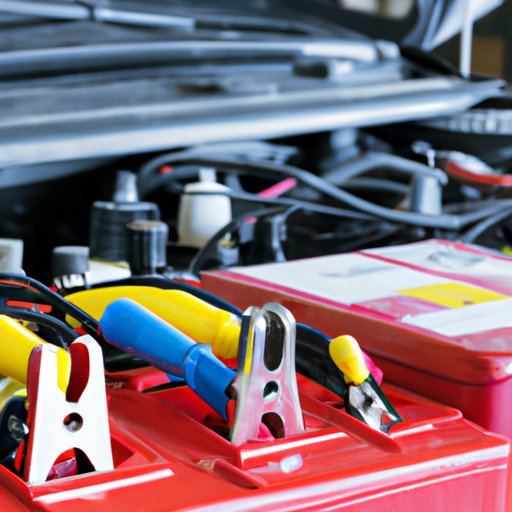Introduction
Your car’s battery is essential for providing power to the electrical components of your vehicle. Without it, your car won’t start or even turn on. That’s why it’s important to regularly test your car battery to ensure that it’s in good working order. Fortunately, you can easily test your car battery at home with a few simple steps.
Check the Voltage with a Multimeter
The first step in testing your car battery is to check the voltage with a multimeter. A multimeter is an instrument used to measure voltage, current, and resistance. To use a multimeter to measure the voltage of your car battery, follow these steps:
- Turn off the engine and remove the keys from the ignition.
- Attach the red lead of the multimeter to the positive terminal of the battery, and the black lead to the negative terminal.
- Set the multimeter to the “Volt” setting.
- Turn the dial to the appropriate voltage range.
- Read the voltage displayed on the multimeter.
A healthy car battery should have a voltage between 12.4 and 12.7 volts. If the voltage is lower than this, it may be time to replace the battery.
Test the Battery’s State of Charge
Another way to test your car battery is to check its state of charge. This can be done with a hydrometer, which measures the specific gravity of the electrolyte solution inside the battery. To use a hydrometer, follow these steps:
- Remove the caps of the battery cells.
- Insert the hydrometer into the electrolyte solution.
- Squeeze the bulb to draw out some of the electrolyte solution.
- Read the specific gravity on the hydrometer.
A healthy battery should have a specific gravity of 1.265 or higher. If the specific gravity is lower than this, it’s time to replace the battery.

Make Sure the Battery Cables are Connected Properly
It’s also important to make sure that the battery cables are connected properly. To do this, follow these steps:
- Check the connections to make sure they are tight and secure.
- Ensure that the cable clamps are not corroded or damaged.
- Check the ground connection to make sure it is clean and free of corrosion.
If there are any loose connections, tighten them and make sure that the cables are firmly connected to the battery terminals.
Check the Alternator Output
The alternator is responsible for charging the battery while the engine is running. To make sure the alternator is working properly, you can check the output with a voltmeter. To do this, follow these steps:
- Start the engine and let it idle.
- Attach the red lead of the voltmeter to the positive terminal of the battery, and the black lead to the negative terminal.
- Set the voltmeter to the “Volt” setting.
- Turn the dial to the appropriate voltage range.
- Read the voltage displayed on the voltmeter.
A healthy alternator should have an output of 13.5 to 14.5 volts. If the output is lower than this, it may be time to service the alternator.
Perform a Load Test
A load test is a great way to make sure that your battery is capable of holding a charge. To perform a load test, follow these steps:
- Connect the load tester to the battery.
- Set the load tester to the appropriate voltage.
- Start the engine and let it idle.
- Run the load test for at least 15 seconds.
- Check the results of the load test.
A healthy battery should have a voltage of at least 9.6 volts after the load test. If the voltage is lower than this, it’s time to replace the battery.

Inspect the Condition of the Battery Terminals
Finally, it’s important to inspect the condition of the battery terminals. Look for signs of corrosion or other damage, such as cracks or breaks. If the terminals are corroded, you can clean them with a wire brush and baking soda. Make sure to wear gloves when handling the battery terminals.
Conclusion
Testing your car battery is an important part of maintaining your vehicle. By following the steps outlined in this article, you can easily test your car battery at home. From checking the voltage with a multimeter to inspecting the condition of the battery terminals, you can make sure that your car battery is in good working order.
(Note: Is this article not meeting your expectations? Do you have knowledge or insights to share? Unlock new opportunities and expand your reach by joining our authors team. Click Registration to join us and share your expertise with our readers.)
